Individual Equipment
| Personal Clothing and Equipment | |
|---|---|
 | The Combat 95 clothing system has to satisfy stringent military requirements covering infra-red reflection, thermal signature and flame resistance. It is based on the layer principle and is designed to provide the soldier with exactly the right degree of protection for any operational environment. The British soldier can expect to operate in extreme climatic conditions, from the jungles of Belize to the arctic wastes of Norway. Combat 95 selects the best from developments in extreme sports and expeditionary wear. |
| Personal Load Carrying Equipment and Body Armour |
|---|
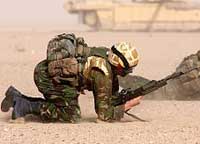 |
| Soldiers need to carry ammunition, water, food and protective equipment. They use Personal Load Carrying Equipment (PLCE), a tough, modular system of camouflaged belt, yoke and pouches. Every soldier has a Mark 6 combat helmet that delivers outstanding ballistic protection while allowing the soldier to still wear a respirator, ear defenders, a radio headset- or all three together. Where additional ballistic protection is required, soldiers are issued Enhanced Body Armour, which can be further reinforced with ceramic armour plates. |
Small Arms and Support Weapons
| SA 80 Individual Weapon and Light Support Weapon |
|---|
 |
SA80 is the designation for a revolutionary family of assault weapons. On its introduction, the L85 Individual Weapon (IW) proved so accurate that the Army marksmanship tests had to be redesigned. The British Army uses the L85 Individual Weapon that replaced the rifle and sub-machine gun, and the L86 Light Support Weapon (LSW) that produces higher volumes of fire and is effective at longer ranges. An infantry section consists of two four-man fire teams armed with SA80s: three IWs and one LSW.
Both weapons have been modified in light of operational experience, and had a major mid-life update in 2002, which resulted in the SA80A2 series - the most reliable weapons of their type in the world.
One new Under slung Grenade Launcher (UGL), designed to be mounted beneath the barrel of the IW, will be issued to each fire team, replacing the Rifle Grenade General Service (RGGS) and 51mm mortar - significantly reducing the ammunition load the infantry section carries, while enhancing its capabilities. The UGL will be able to fire 40mm High Explosive (HE), smoke and illuminating rounds out to a range of 350 m to destroy, obscure or indicate enemy positions.
The GP rifle, a single shot version of the IW in service with the Army Cadets.
L85 Individual Weapon Calibre 5.56 mm Weight 4.98 kg (with loaded magazine and optical sight) Length 785 mm Barrel Length 518 mm Muzzle Velocity 940 m/s Feed 30 round magazine Effective Range 400 m Cyclic Rate of Fire 610-775 rounds per minute L86 Light Support Weapon Calibre 5.56 mm Weight 6.58 kg (with loaded magazine and optical sight) Length 900 mm Barrel Length 646 mm Muzzle Velocity 970 m/s Feed 30 round magazine Effective Range 1000m Cyclic Rate of Fire 610-775 rounds per minute. |
| Sniper Rifle |
|---|
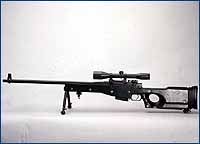 |
Designed to acheive first-round hit at 600m and harassing fire out to 1100m, the superb Accuracy International L96 sniper rifle has been upgraded with a new x3-x12 x 50 sight and spotting scope. Selected units also field the L115A1 Long range Rifle (LRR), which fires an 8.59mm bullet, heavier than the 7.62mm round of the L96 and less likely to be deflected over extremely long ranges.
Sniper Rifle L96 Calibre: 7.62mm Weight: 6.5kg Length: (adjustable) 1124-1194mm Muzzle velocity: 838m/s Feed: 10-round box Effective range: 900m, harassing fire 1100m Long Range Rifle L115A1 Calibre: 8.59mm Weight: 6.8kg Length: 1300mm Muzzle velocity: 936m/s Feed: 5-round box Effective range: 1100m plus |
| 5.56mm Light Machine Gun |
|---|
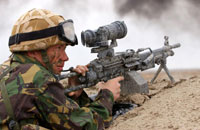 |
Minimi belt fed 5.56mm Light Machinegun (LMG), is entering service on a scale of one per four-man fire team. The Minimi has been used operationally by British troops in Afgahnistan and Iraq.
Calibre 5.56mm Weight 7.1kg Length 914mm Feed 100-round disintergrating belt Effective range 800m Cyclic rate of fire 700 to 1000 rounds per minute |
| 7.62mm General Purpose Machine Gun |
|---|
 |
The General Purpose Machine Gun (GPMG) can be used as a light weapon, mounted on a bipod. It can also be seen in a sustained fire role, mounted on a tripod and fitted with the C2 optical sight. In this role , it will be a two-man team who grouped in a specialist Machinegun Platoon to provide battalion-level fire support. Versions of the GPMG are mounted on most Army vehicles and some helicopters.
Calibre 7.62mm Weight 13.85kg (gun plus 50 round belt) Length 1230mm (light role) Barrel length 629mm Muzzle velocity 838m/s Feed 100-round desintergrating link belt Effective range 800m light role, 1800m sustained fire role (tracer burn out at 1100m)Cyclic rate of fire 750 rounds per minute |
| .5 Inch Heavy Machine Gun |
|---|
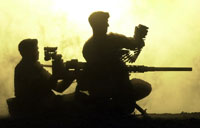 |
The powerful L1A1 12.7 mm Heavy Machine gun (HMG) is an updated version of the Browning M2 'Fifty-cal' - recognised as one of the finest heavy machine guns ever developed. Currently, the HMG provides integral close-range support from a ground mount tripod or fitted to a Land Rover TUM using a Weapon Mount Installation Kit (WMIK) and a variety of sighting systems. The performance of the HMG has recently been enhanced with a new 'soft mount' (to limit recoil and improve accuracy) and a quick change barrel.
Calibre: 12.7mm Weight: 38.15kg (gun only) Length: 1,656mm Barrel Length: 1,143 Muzzle Velocity: 915 m/s Feed: 50 round disintegrating belt Effective range: 2000m Cyclic rate of fire: 485 - 635 rounds per minute |
| Light Anti-armour Weapon |
|---|
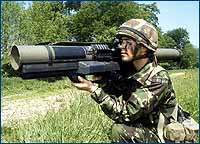 |
| The Light Anti-armour Weapon (LAW) is a 94mm,disposable, one-man-portable, High Explosive Anti Tank (HEAT) rocket system capable of destroying armoured targets at ranges up to 500m. A built-in spotting rifle and low-light sight increase the weapons accuracy. Law will be replaced by Next Generation Light Anti-tank Weapon (NLAW), an Overfly Top Attack (OTA) system, with a range of 200 to 600m. |
| Milan Portable Anti-Tank Guided Weapon |
|---|
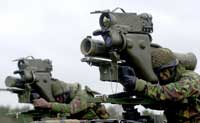 |
Milan is a combat proven, medium-range, anti-tank missile system, comprising a launch and control unit (firing post) and a disposible launch tube containing the missile. A semi-automatic line of sight (SACLOS) system, the operator only has to keep the cross hairs of his sight on the target, while the computer n the control unit steers the missile in.
From 2005, Milan will be replaced by Javelin Light Forces Anti-tank Guided Weapon (LF ATGW). Capable of defeating Main Battle Tanks (as well as lighter armoured vehicles and defensive positions) at ranges out to 2500m, Javelin can even be fired from inside a building.
Missile: Max Range 2,000m
Min Range: 400m
Length: 918mm
Weight: 6.73kg
Diameter: 125mm
Wing Span: 267mm
Rate of Fire: 3-4rpm
Warhead Weight: 2.70kg
Diameter: 115mm
Explosive Content: 1.79kg
Firing Post Weight: 16.4kg
Length: 900mm
Height: 650mm
Width: 420mm
Armour Penetration: 352mm
Time of Flight to Max Range: 12.5secs
Missile Speed: 720kph
Guidance: Semi-Automatic command to line of sight by means of wire guidance link.
|
| 51mm Light Mortar |
|---|
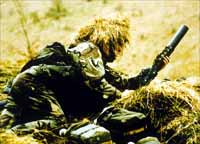 |
The 51mm Light Mortar is a Platoon level, indirect fire weapon that can be carried and fired by one man. The mortar is used to fire smoke, illuminating and HE rounds out to a range of approximately 750m; a short range insert device enables the weapon to be used in close quarter battle situations with accuracy.
Range 750m
Bomb Weight 800 grams (illumination),
900 grams (smoke),
920 grams (High Explosive)
Rapid Rate of Fire 8 rounds per minute
Length of barrel 700mm
Weight Complete 6.275 kg
Calibre 51.25mm
|
| 81mm Mortar |
|---|
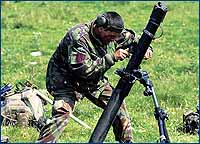 |
81mm Mortar
The battle-proven L16A2 81mm Mortar delivers accurate High Explosive (HE), Smoke or Illuminating rounds out to a range of 5650m. The 81mm Mortar can be man-packed in three loads, but mortar detachments are normally vehicle-borne. Mortar platoons in armoured Infantry battalions are mounted in - and can fire from - FV 432 armoured vehicles increasing the mortars mobility and speed into and out of action. The 81mm mortar provides an Infantry battalion with its own indirect fire support.
Equipment Update:
This weapon system, which is lightweight, simple to use and flexible has undergone a mid life upgrade (MLU) to embrace recent technological developments. The inclusion of the new SPGR (Specialised Personal GPS Receiver) and LH40C (Laser) combine to make the new TLE (Target Locating Equipment). This generates a significant enhancement in first round accuracy and the ease, and speed, with which accurate fire missions can be executed. Additionally, the equipment reduces the number of adjustment rounds which will be used and lead to greater dispersal of mortar barrels, thus increasing protection for the mortar crew soldiers. Plans continue to develop further synergies with The Royal Artillery to improve the existing levels of co-ordination between Artillery and Mortars in fighting the indirect fire battle.
Calibre 81mm Weight 37.94k Barrel length 1280mm Muzzle Velocity 225m/s Max Range HE 5,650m Rate of Fire 15 rounds per minute |
Armoured Fighting Vehicles
| Warrior |
|---|
 |
The Warrior Infantry Fighting Vehicle has the speed and performance to keep up with Challenger 2 Main Battle Tanks over the most difficult terrain, and the firepower and armour to support infantry in the assault. A highly successful armoured fighting vehicle, Warrior can be fitted with Enhanced Armour and is continuously being updated; for example, the Battlegroup Thermal Imager (BTI) is being fitted to increase its night-fighting capability.
Warrior infantry command and section vehicles carry a turret mounted 30 mm Rarden cannon that will defeat light armoured vehicles out to 1,500 m. An 8x magnification image-intensifying night sight is fitted, and eight 94 mm Light Anti-Armour Weapon (LAW) HEAT rockets can be stowed in the vehicle.
Warrior variants include artillery observation post vehicle (OPV) and command post vehicle (CPV), and a Royal Mechanical and Electrical Engineers (REME) recovery and repair vehicle. All variants are equipped with a 7.62 mm chain gun: both chain gun and Rarden cannon have an anti-helicopter capability.
Crew 3 + 7 troops. Hull Length 6.34 m. Height to Turret Roof 2.791 m. Width 3.034 m Ground Clearance 0.49 m. Combat Weight 24,500 kg. Main Armament 1 x 30 mm L21 Rarden cannon. Secondary Armament Co-axial 7.62 mm chain gun. Smoke grenade dischargers. Engine Rolls Royce CV8 diesel. Maximum Speed 75 kph. Maximum Range 660 km. |
| photo photo photo photo photo |
| Spartan |
|---|
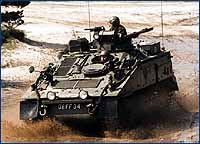 |
Spartan is a derivative of the CVR(T) vehicle (Combat Vehicle
Reconnaissance tracked). Spartan is used by specialist troops which can
include Mortar Fire Control Teams, anti aircraft teams equipped with HVM, or
as Engineer Command/Reconnaisance Vehicles.
Length 5.12m; Width 2.24m; Height 2.26m; Weight 8.17 tonnes; Max Road Speed 80.5kph; Engine Jaguar 4.2 litre; Crew Commander, driver and 5 crew; Armament 7.62mm machine gun. |
| photo |
| Samaritan |
|---|
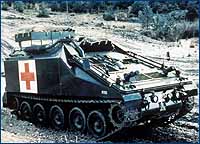 |
Samaritan is a derivative of the CVR(T) vehicle - it is an armoured ambulance equipped with stretchers.
Length 5.07m; Width 2.24m; Height 2.42m; Weight 8.66 tonnes; Max Road Speed 72.5kph; Engine Jaguar 4.2 litre; Crew Commander, driver, up to 6 casualties; Armament Nil. |
| Samson |
|---|
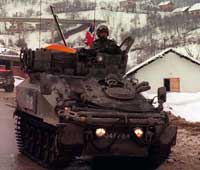 |
Samson is a derivative of the CVR (T) Vehicle (Combat Vehicle Reconnaissance Tracked) - it is the Armoured Recovery Vehicle for all the vehicles in this class.
Length 4.79m; Width 2.43m; Height 2.25m; Weight 8.74 tonnes; Max Road Speed 72.5kph; Engine Jaguar 4.2 litre; Crew Commander, driver and crew; Armament 7.62mm machine gun. |
| Striker |
|---|
 |
The Tank Hunter of the family, Striker is a CVR(T) with a primary role to destroy enemy armour. The vehicle carries 10 swingfire anti-tank missiles, with a range of up to 4,000 m. Five of these missiles are carried in launch bins on top of the vehicle. The missile is tracked by the controller using a direct optical or thermal sight mounted on the vehicle, or a separate optical sight that can be deployed up to 100 m away, with the Striker in cover.
Crew 3. Length 4.8 m. Height 2.2 m. Width 2.4 m. Ground Clearance 0.35 m. Combat Weight 8,130 kg. Armament Swingfire SACLOS anti-armour missiles. Secondary Armament 1 x 7.62 mm GPMG. Ammunition Carried 10 Swingfire missiles, 7.62 mm x 3,000 rounds. Engine Cummins B6 diesel. Maximum Speed 80 kph |
| Sultan |
|---|
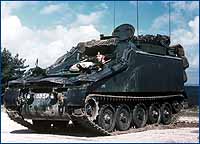 |
| Sultan is the Command and Control variant of the CVR(T) family of vehicles which came into service in 1972. Light and highly mobile, Sultan is used as a Command or Headquarters vehicle in armoured and armoured reconnaissance formations. |
| Saxon AT-105 |
|---|
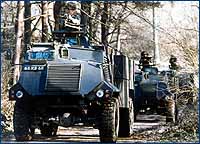 |
Saxon is a wheeled Armoured Personnel Carrier (APC) capable of travelling across rough terrain and fording water obstacles up to 90 cm depth. The vehicle has excellent battlefield mobility and is extremely versatile.
Saxon variants in service include a Royal Electrical and Mechanical Engineers
(REME) recovery vehicle; armoured ambulance; command post vehicle; internal
security version; and vehicles modified to carry an L37 General Purpose
Machine Gun (GPMG) turret.
Crew 2 + 10 troops. Hull Length 5.16 m. Height 2.63 m. Width 2.48 m. Ground Clearance (axles) 0.33 m. Combat Weight 10,670 kg. Main Armament 1 x 7.62 mm GPMG. Engine 164 bhp Bedford 600 6-cylinder diesel (Cummins BT 5.1 fitted to IS variant). Maximum Speed 96 kph. Maximum Range 510 km. Armour Proof against 7.62 mm rounds at point-blank range |
| photo |
| Scimitar |
|---|
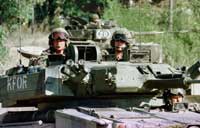 |
Scimitar is a fast and agile armoured vehicle with a primary role to gather information. The vehicles exceptionally low ground pressure and small size make it useful where the terrain is hostile and movement difficult. Scimitar carries a 30mm Rarden cannon for self-defence. It is used by reconnaissance regiments of the Royal Armoured Corps and 'recce' elements of the armoured infantry.
Crew 3 Length 4.9m Height 2.1m Width 2.24m Ground Clearance 0.35m Combat weight 8,070kg Main armament 1 x 30mm L21 Rarden cannon Secondary armament Coaxial 7.62mm GPMG, Smoke grenades Ammunition carried 160 rounds of 30mm, 3,000 rounds of 7.62mm Engine Cummins BTA 5.9 diesel engine developing 190hp. Maximum speed 80 kph |
| Sabre |
|---|
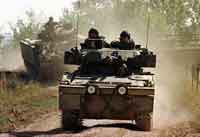 |
Sabre is used for close reconnaissance by Armoured Infantry and Mechanised
Infantry battalions. Very similar to Scimitar, with the turret roof slightly
lower and a co-axial chain gun instead of the GPMG, Sabre is a hybrid produced
by mounting the turret of a Fox Combat Vehicle Reconnaissance (Wheeled) on the
hull of a Scorpion CVR(T).
Crew 3. Length 4.79 m. Height 2.17 m. Width 2.24 m. Ground Clearance 0.35 m. Combat Weight 8,130 kg. Main Armament 1 x 30 mm L21 Rarden cannon. Secondary Armament Co-axial 7.62mm chain gun, Smoke Grenade dischargers Ammunition carried 160x30mm rounds- Armour-piercing Enhanced Penetration (APEP) and High Explosive (HE) 3000x7.62mm rounds Engine Cummins BTA 5.9 diesel engine developing 190hp. Maximum Speed 80kph. |
| Challenger |
|---|
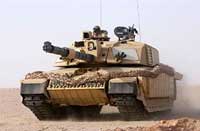 |
The superb Challenge 2 (CR2) is the British Army's Main Battle
Tank. CR2 is based on the Challenger 1 that served with distinction on
operations in the Gulf War and the Balkans. Only 5 per cent of Challenger 2
components are interchangeable with its predecessor; over 150 major
modifications include a completely new turret, L30 CHARM 120mm gun and second
generation Chobham armour. Challenger 2's Thermal Observation and Gunnery
(TOGS) displays a magnified image for the commander and gunner. The commander
has a gyrostabilised fully panoramic sight with laser range finder and thermal
imager. The gunner is equipped with a gyrostabilised primary sight with a
laser range finder and coaxially mounted auxiliary sight. The drivers position
has an image-intensifying day and night periscope, and the loader has a day
sight.
Crew 4 Length Gun Forward 11.55m; Hull Length 8.3m; Height to Turret Roof 2.49m; Width 3.5m; Ground Clearance 0.5m; Combat Weight 62,500 kg; Main Armament 1 x 120mm L30 CHARM Gun (CHallenger main ARmament); Ammunition Carried Typically 50 rounds - APFSDS, HESH, Smoke; Secondary Armament Co-axial 7.62mm chain gun; 7.62mm GPMG Turret Mounted for Air Defence; Ammunition Carried 4000 rounds 7.62mm; Engine 1200bhp Perkins-Condor CV12; Maximum Road Speed 59km/h; Average Cross Country Speed 40km/h. |
Artillery and Air Defence
| 227mm Multiple Launched Rocket System (MLRS) |
|---|
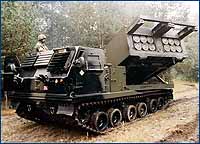 |
The 227mm Multiple Launch Rocket System (MLRS)is a self-propelled
artillery rocket system with a range in excess of 30 km. MLRS is self-loaded
with two rocket pods, each containing six rockets. Loading is power assisted
and a single round 'fire for effect' of 12 rockets delivers 7,728 bomblets or
336 anti-tank mines. Operated from hides, usually as a battery of nine
launchers, MLRS avoids counter attack by 'shooting and scooting' - moving fast
and frequently between fire-missions.
Crew 3; Weight loaded 24,756 kg; Length 7.167m; Width 2.97m; Height (stowed) 2.57m; Height (max elevation) 5.92m; Max Road Speed 64 kph; Road Range 480km; Engine Turbo-charge 8 cylinder diesel; Rocket Diameter 227mm; Rocket Length 2.93m; Rocket Weight M77 Bomblet 302.5kg; AT2 SCATMIN 254.46kg; Range M77 Bomblet 11.5-32 kms; AT2 SCATMIN 39 kms. |
| AS 90 |
|---|
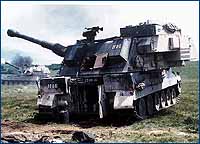 |
AS90 is a 155mm self-propelled gun that equips six Field Regiments of
the Royal Horse Artillery and Royal Artillery. Fitted with a standard barrel,
AS90 can fire the NATO L15 unassisted 155mm projectile (96lbs) 24.7 km. With a
long (52 Calibre) barrel the gun can reach out to 30 km using standard
ammunition, and 60-80 km with Extended Range (ERA). AS90 is equipped with an
autonomous Navigation and Gun Laying system (AGLS) based on the vehicles
inertial navigation system, the Dynamic Reference Unit (DRU). All main turret
functions are controlled by the Turret Control Computer (TCC).
Crew 5 Length 9.07m Height to turret roof 2.49m Width 3.5m Ground clearance 0.41m Main armament 1 x L31 39-calibre ordnance Ammunition carried 48 x 155mm rounds Secondary armament 1 x 7.62 GPMG on turret for air defence. Engine Cummins VTA903T turbocharged V8 660bhp diesel. |
| 105mm Light Gun |
|---|
 |
The versatile 105 mm Light Gun is used by the Parachute and Commando Field Artillery Regiments of the British Army. The Light Gun can be towed by a medium-weight vehicle (such as a Pinzgauer TUM/HD or Hagglund BV206 all-terrain vehicle) or carried around the battlefield underslung by a Puma or Chinook helicopter.
Royal Artillery L118 Light Guns are fitted with an Automatic Pointing System, which enables the gun to be unlimbered and in action in 30 seconds. APS is based on an inertial navigation system; operated via a touch screen, it replaces the traditional dial sight. New Light Gun ammunition is in development, with an increasingly lethal round and an extended range.
Crew 6. Length Gun Forward 8.8 m. Height 2.13 m. Width 1.78 m. Combat Weight 1,858 kg. Ammunition HE, Smoke, Illuminating, Target Marketing. Maximum Range (HE) 17.2 km. Shell Weight (HE) 15.1 kg |
| Starstreak HVM |
|---|
 |
The Starstreak HVM (High Velocity Missile) is designed to counter threats from very high performance, low-flying aircraft and fast 'pop up' strikes by helicopter attacks. The missile, which travels at more than three times the speed of sound, uses a system of three dart-like projectiles, allowing multiple hits on the target. HVM can be fired from the shoulder, from a lightweight multiple launcher of from the Stormer armoured vehicle, which is equipped with an eight-round launcher and carries another 12 missiles inside the vehicle.
Missile Length 1.369 m. Missile Diameter 0.27 m. Missile Speed Mach 3+. Maximum Range 5 km. Minimum Range 300 m. |
| Rapier Field Standard C (FSC) |
|---|
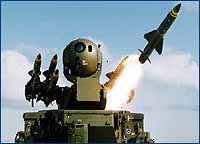 |
Rapier Field Standard C (FSC) provides Low Level Air Defence over the
battlefield. The system consists of a launcher with eight ready-to-fire
missiles and an electro-optical tracker. each fire unit can cover an Air
Defence Area (ADA) of approximately 100km square.
Guidance Semi-automatic line of sight (SACLOS) Missile length 2.35m Missile diameter 0.133m Motor Solid-fuelled Missile speed Mach2+ Maximum range 8km approx Launch weight 42kg Fire unit height 2.13m Fire unit weight 1227kg Radar height (in action) 3.37m Radar weight 243kg |
| Air Defence Alerting Device |
|---|
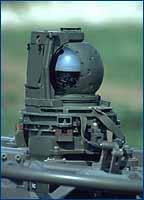 |
| The Air Defence Alerting device is a passive air defence alerter designed to work in conjunction with the HVM missile system. Operating as an infra red search and tracking system in the 8 - 14 micron waveband, the alerter is designed to operate against low and fast moving fixed wing aircraft, as well as the latest generation of attack helicopters. The alerter can be ground mounted to support shoulder launched / LML HVM or vehicle mounted on the Stormer HVM vehicle. |
Engineer Equipment
| Infantry Foot Bridge |
|---|
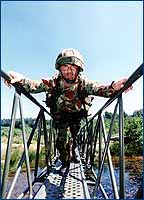 |
| Two Infantry Foot Bridge bridges will allow a company of soldiers to cross an obstacle in under five minutes. Used by the Assault Pioneer platoons of air-mobile and air-portable infantry units, this is a versatile and lightweight aluminium bridging system that can be carried on a four tonne truck. The bridge can be assembled quickly and quietly, and can take three fully equipped infantrymen at a time..
One Bridging Set comprises 8 bridge modules, each of 4.43 metres in length; Spans dry gap 16 metres, wet gap 30 metres. A bridging set is carried by a single 4 or 8 ton truck. |
| Combat Engineering Tractor (CET) |
|---|
 |
The Combat Engineer Tractor (CET) is a tracked, armoured, amphibious vehicle equipped with a 100m winch cable attached to an anchor that can be fired by rocket. Once the anchor has bedded in, the CET can use its powerful winch like a grappling hook to climb steep slopes and riverbanks. Capable and versatile, CET's have proven invaluable in operations worldwide. The Royal Engineers use CET to clear obstacles, dig gun pits, prepare barriers and tow other vehicles out of difficult positions.
A new specialist engineer armoured vehicle, Terrier, will soon replace CET from 2008. Faster, more mobile and with more effective armour and mine protection than CET, Terrier will be operated by a crew of two - or may be operated remotely in particularly hazardous environments. Terrier will be fitted with day and night vision systems and, although (at 30 tonnes) twice as heavy as CET, it will be air-portable in C17 or A400M transport aircraft
Weight 17,010kg Length 7.54m Height 2.67m Road Speed 56 kph Road Range 480 km's Fuel Capacity 430 litres Engine Rolls-Royce C6TCR Engine Power 320 bhp Crew 2 Armament 1 x 7.62 machine gun |
| Tank Bridge Transporter (TBT) |
|---|
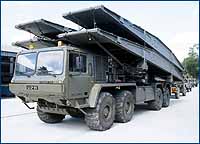 |
The Unipower 8x8 TBT is an improved mobility transporter for the new BR 90 bridging system. It can carry one No 10 bridge or two No 12 bridges. The TBT can self load from, and off-load to, the ground.
Weight 35 tonnes when loaded (21 tonnes unladen) Height 3.9m Length 16.2m Width 4m Max Speed 80 kph Engine Diesel Crew 2 |
| Medium Wheeled Tractor |
|---|
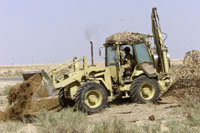 |
| The Medium Wheeled Tractor is a commercially available articulated bucket loader. It is used for mobility and counter mobility tasks by the Royal Engineers in Close Support and General Support Engineer regiments. |
| Foden GS 6 x6 Recovery Vehicle |
|---|
 |
A heavy recovery vehicle employed primarily in support of the wheeled logistic vehicle fleet to recover immobilised vehicles as a result of bogged down in soft ground or broken down. The vehicle is fitted with a powerful hydraulic winch, crane and outriggers.
Crew 1+3 troops Length 9.06m Height 3.35 Width 2.48m Weight (Laden) 25338kg Maximum speed 97kph |
| Challenger Arrmoured Repair and Recovery Vehicle (CHARRV) |
|---|
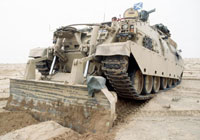 |
CHARRV is a highly evolved armoured vehicle designed to recover and repair damaged tanks on the battlefield. The vehicle has two winches and an Atlas crane capable of lifting a complete Challenger 2 power pack. The dozer blade can be used as an earth anchor, as a stabiliser for the crane, or to clear obstacles and dig fire positions. based on Challenger components, the CHARRV carries a crew of three plus two Royal Electrical and Mechanical Engineers (REME) fitters in a seperate compartment.
Crew 3+2 Length 9.61m Height to turret roof 3.13m Width 3.62m Ground Clearance 0.5m Combat weight 61200kg Armament 1x 7.62mm GPMG, Smoke dischargers Maximum crane lift 6500kg at 4.9m reach Engine 1200bhp Perkins-Condor CV12 Maximum speed 59kph Average cross-country speed 40kph |
| M3 Amphibious Rig |
|---|
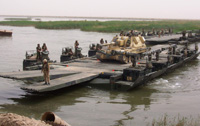 |
The M3 can be driven into a river and used as a ferry or, when a number are joined together from bank to bank, as a bridge, capable of taking vehicles as heavy as the Challenger MBT. A 100m river can be crossed in 30 minutes, using 8 rigs.
* Weight 24.5 tonnes; * Height 3.93m; * Length 12.74m; * Width 3.35m; * Max Speed 80kph; * Engine diesel; * Crew 3. |
| Armoured Vehicle Launcher Bridge (AVLB) |
|---|
 |
The AVLB launches a single Close Support Bridge to cross gaps of up to 24.5m or a combination of such bridges to cross gaps of up to 60m. A single bridge can be laid in about 3 minutes without exposing the crew. Once the bridge has been laid the launch vehicle can drive over it and recover it from the far bank.
* Weight 53,300 kg; * Length 13.74m; * Height 3.92m; * Width 4.16m; * Max Speed 42 kph; * Crew 3; * Armament 2 x 7.62mm machine guns. * Engine diesel. |
| Shielder |
|---|
 |
| Engineers have to clear obstacles - and create them too. The British Army Shielder Syatem gives commanders the facility to create anti-tank barriers quickly and effectively. The system consists of modular dispensers which can be fired to either side or to the rear, mounted on a flat bed version of the Stormer Armoured Personnel Carrier. The anti-tank mines have a prgrammable life, at the end of which they self-destruct. The British Army does not use anti-personnel mines. |
Logistics Vehicles
| Truck Utility Light / Medium (TUL/TUM) |
|---|
 |
| Approximately 15,000 Land Rovers are in service with the British Army worldwide. Army Land Rovers are militarised Defender 90s and 110s, and the high performance Wolf. Designated the Trucks Utility Light (TUL) and Medium (TUM), Army Land Rovers carry reconnaissance and fire control teams, support weapons with their crews and ammunition, and communication and information systems for commanders. Some Wolf Land Rovers TUM(HS) are winterised and waterproofed: a snorkel allows the vehicle to wade through water up to windscreen level and an engine fluids heater is fitted to pre-warm the engine - along with the other modifications to enable the vehicle and crew to operate in extreme conditions. Other vehicles are stripped down and fitted with roll cages and weapons mounts - the Weapons Mount Installation Kit (or 'Wimik') - for use as reconnaissance and close fire support vehicles. Typically the vehicle will carry one 12.7mm Heavy Machine Gun and a 7.62mm General Purpose Machine Gun. |
| All Terrain Mobility Platform (ATMP) |
|---|
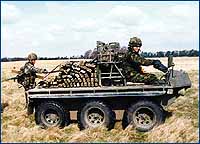 |
The All-Terrain Mobility Platform (ATMP) 'Supacat' is a versatile, lightweight load-carrying vehicle used by airborne and air-mobile battalions. Amphibious, and with a very low ground pressure, the ATMP's six wheels allow it to cross rough terrain and water obstacles. Used for re-supply, casualty evacuation radio rebroadcast and refuelling, ATMP can carry a single NATO standard pallet, ammunition, anti-tank mines and other bulky or heavy stores. It can be fitted with a General Purpose Machine Gun (SF) to provide mobile fire support.
Crew 2 + 8 troops Length 3.44m Width 2.03m (wheel to wheel) Height 1.85m (open top to top of restraint frame). 2.01m (cabbed vehicle) Weight (ATMP Mk2) (Laden) 2,000kg Engine VW ADE 1.9 turbocharged diesel |
| Truck Utility Medium TUM(HD) |
|---|
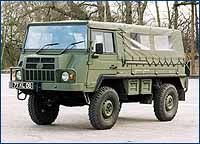 |
The Pinzgauer 716M Truck Utility Medium (Heavy Duty) - TUM(HD) - and
the Reynolds Broughton RB 44 Truck Utility Heavy (TUH) perform a variety of
utility roles, from carrying stores to acting as command and communications
vehicles. The Pinzgauer is used as a gun tractor for the 105mm Light Gun, and
can be carried in a C130 aircraft or ferried around the battlefield by a RAF
Chinook helicopter as an underslung load.
TUH Weight (laden) 5,300kg. Payload 1,400kg. Maximum speed 109kph. TUM(HD) Weight (laden) 3,850kg. Payload 1,400kg. Maximum speed 122kph. |
| DROPS |
|---|
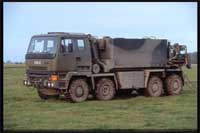 |
Demountable Rack Offload and Pickup System (DROPS) vehicles form the logistic backbone of the British Army. There are two types of vehicle - the Leyland Medium Mobility Load Carrier (MMLC), and the Foden Improved Medium Mobility Load Carrier (IMMLC). Both trucks are 8x6 load carriers with a 15-tonne flatrack payload, allowing the rapid loading and unloading of flatracks or containers. IMMLC is used primarily as an ammunition carrier in support of AS90 155mm self-propelled guns. MMLC operates solo, or towing a skeleton trailer. It can be deployed with Simple Rail Transfer Equipment (SRTE) for unloading and loading railway flat cars.
Length 9.11m. Height 3.18m. Width 2.5m. Weight (kerb) 14,040kg. Weight (laden) 32,000kg (MMLC), 32,960kg (IMMLC). Engine 350hp Perkins Eagle diesel |
| Motorcycles |
|---|
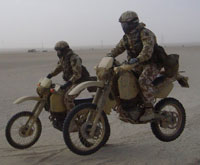 |
| The Harley Davidson MT350E and Honda R250 are used by Army dispatch riders and for a variety of liaison and traffic control tasks. The bikes are fitted with document panniers and a carrier for the SA80A2 Individual Weapon. |
| Truck Cargo 14 Tonne 6x6 Medium Mobility |
|---|
 |
| The powerful Bedford 14 tonner can carry troops, but is is usually found moving NATO standard pallets, load containers or fuel. |
| Truck Cargo 8 Tonne 4 x 4 Medium Mobility |
|---|
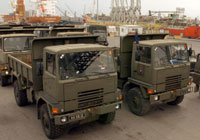 |
| The Bedford TM Medium Mobility 8-tonne truck carries 20 troops, 6 NATO standard pallets, unit load containers, general stores or fuel loads and certain container loads. The truck can tow a trailer of up to 8 tonnes gross weight on roads or tracks, and may be fitted with a winch or crane. |
| Heavy Equipment Transport |
|---|
 |
Tank Transporters or Heavy Equipment Transporters are capable of pulling an immobilised tank on board, and can carry 70-tonne Main Battle Tanks. They can move their load rapidly and cost-effectively, saving wear and tear on the tracks - and the roads. The semi-trailers are equipped with a heavy-duty winch - giving an all-up weight of 104 tonnes.
The new Heavy Equipment Transporter (HET) is the most powerful tank transporter in production. It consists of an Oshkosh 1070F 8x8 tractor truck and a King Trailer GTS 100 seven axle semi-trailer. Its after-cooled Caterpillar C18 turbocharged diesel engine develops 700hp.
Heavy Equipment Transporter Gross vehicle weight 44,900kg. Gross train weight 118,050kg. Speed 85kph. Oshkosh 1070F 8x8 tractor truck Wheelbase 5.461m. Engine Turbocharged and aftercooled Caterpillar C18 700hp 18.1 litre six-cylinder in-line diesel. King Trailer GTS 100 seven axle semi-trailer Length 11.5m. Width 2.9m (increased to 3.47m with outriggers). |
| CARRIER FULL-TRACKED ARTICULATED BV206 |
|---|
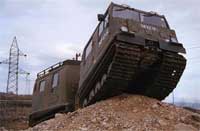 |
The Hagglund BV206 is used by Army Artillery, Engineer and Signals units forming part of the Commando Brigade. Designed for use in snow, the amphibious BV206 has proved just as capable over soft ground or even desert sand. The lightweight vehicle consists of two powered, tracked cars. The joint between the cars permits steering by articulating the vehicle. BV206 can tow a 105mm Light Gun or an equipment trailer.
Length 6.9m. Height 2.4m. Width 1.87m. Combat weight 6,470kg. Maximum speed (roads or compacted snow) 52kph. Maximum range 300km. |
| Truck Cargo 4 Tonne GS |
|---|
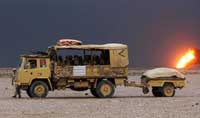 |
| The 4x4 Leyland/DAF 4-tonne GS (General Service) is the latest version of the Army's 'Four Tonner', the trusty Army lorry encountered wherever British troops are to be found. The truck can carry 20 troops (plus 3 in the cab) or 3 NATO standard pallets, and may be encountered with a variety of specialist bodies, or a 6.3 tonne crane. The 4-tonne GS is air-portable in a C130 Hercules aircraft. |
The Electronic Battlefield
| Man-portable Surveillance and Target Acquisition Radar (MSTAR) |
|---|
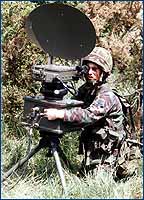 |
| MSTAR is a lightweight all-weather battlefield radar, able to detect helicopters, vehicles and infantry to a range in excess of 20km. Powered by a standard Army field battery, MSTAR is used by artillery observers to detect fall of shot. The electro-luminescent display shows dead ground, relief and target track history, and a 1:50,000 map grid can be superimposed to simplify the transfer of information to and from military maps. The 30kg radar can be carried in a vehicle (for example, Warrior Observation Post Vehicle) or broken down into three easily man-packed loads |
| Satellite Communications (SATCOM) |
|---|
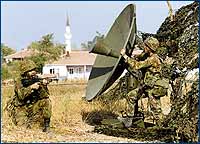 |
| The Royal Signals deploys transportable and manpack satellite ground stations, to provide communications links for headquarters or small groups located in remote parts of the world, via its SKYNET 4B system. Operations in the Falklands and Namibia proved the value of satellite communications and during the Gulf war there was an extensive use of SATCOM ground terminals. It is expected that a new series of SKYNET 5 satellites will be introduced to enhance SATCOM facilities in the future. |
| Intelligence, Surveillance, Target Acquisition and Reconnaisance Equipment (ISTAR) |
|---|
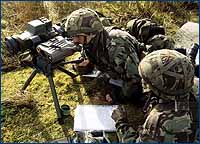 |
| Intelligence, Surveillance, Target Acquisition And Reconnaissance (ISTAR) equipment includes image-intensifying goggles, lightweight thermal imagers and laser target markers. Thermal imaging (TI) turns heat into light - allowing the user to see through darkness, rain or undergrowth. Body heat makes people appear bright: vehicles are visible by the heat from their engines - or even from warm tyres. LION is a lightweight thermal imager used at platoon level to detect targets at medium range, while Sophie is a long-range system deployed at company level. TADS is a thermal imaging sight which can be fitted to the long-range L96 Sniper Rifle used by sniper teams. Larger and more powerful thermal imagers are Spyglass and OTIS, which is used by artillery observers and is normally mounted on the Warrior Observation Post Vehicle. |
| Ptarmigan |
|---|
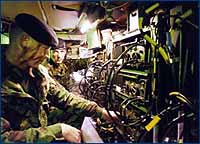 |
| Ptarmigan is a mobile, secure battlefield system that has been designed to improve communications reliability, capacity and interoperability. The system consists of a network of electronic exchanges or trunk switches connected by the satellite and multi-channel radio relay (Triffid) links. These provide voice, data, telegraph and fax communications. Ptarmigan also has a mobile phone or single channel radio access (SCRA), which gives mobile users an entry point to the system. Ptarmigan ensures that the headquarters have exceptional flexibility in siting and have trunk communications that do not impose constraints on operations. |
| Artillery Locating Radar |
|---|
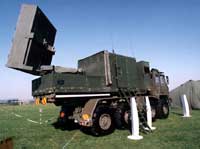 |
| Artillery Locating Radar detects an incoming shell or mortar bomb at two points during its flight, and quickly calculates the position of the enemy battery, so that the Royal Artillery can engage enemy guns or mortars with counter-battery fire, before the enemy has time to move. Two new British Army systems are Arthur (Artillery Locating Radar) and Cobra. |
| Clansman | |
|---|---|
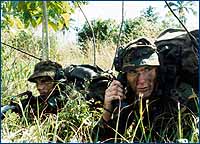 | Clansman is the in-service family of tactical radios with which the British Army is currently equipped to provide communications from formation headquarters forward to the fighting units. CLANSMAN is a lighter, far more reliable and adaptable system than the LARKSPUR system that it replaced. In its turn CLANSMAN will be replaced by Bowman. |
| BowMan | |
|---|---|
| Bowman is replacing the Army's ageing Clansman radio and certain elements of the Ptarmigan trunk communication system. Bowman is a staged delivery programme where capability is developed and delivered in increments. Bowman's initial operating capability was delivered into service in March 2004, with provisos. | |
 | A communication system for tomorrow - today. Bowman is not simply a replacement for the aging and analogue based Clansman military radios. Bowman provides our forces with the latest digital voice and data communications technology in a package that will significantly improve command and control. |
| A step-change in capability. Bowman brings military communications into the 21 st century through: Secure Tactical Communications. With Bowman there will no longer be a requirement to encode and decode radio messages using paper code. This alone is a quantum leap in capability. Enhanced Situational Awareness. Each Bowman radio has a built in Geographical Positioning System processor that is programmed to update all other radio users connected to the network. This will increase effectiveness by reducing unnecessary radio traffic and removing any doubts regarding the location of our own forces. Reliable Data Network. This ensures secure digital communications and support automatic position, location and navigation reporting individuals and units. | |
 | A system designed to keep pace with technology. Bowman is already in service but is being fielded incrementally. This means that the most up to date software and functionality can be added as required in a timely manner. |
 | A communication system not just a radio. Bowman is an extremely complex system that brings together a range of software functionality in a number of different hardware configurations. All of this in turn needs to be integrated with an array of platforms. Getting this right takes time. |
 | British forces deserve the best. Achieving instant perfection and reliability is neither probable nor possible, and complex equipment such as Bowman requires rigorous testing and evaluation at every step. This is done to provide the best equipment for our forces whilst representing the best value for money to the taxpayer. |
| Phoenix | |
|---|---|
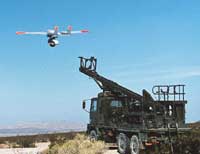 | The Royal Artillery's Phoenix Unmanned Aerial Vehicle (UAV) can be launched within an hour of arriving at the launch site. It is an all-weather, day or night, real-time surveillance and target acquisition system. Phoenix's surveillance suite is data-linked to a ground station which, in turn, transmits the intelligence gathered directly to artillery command posts. Two Phoenix UAVs can be controlled from the same ground control station. Phoenix is made from Kevlar, glass fibre, carbon-reinforced plastics and Nomex honeycomb and powered by a 25 hp two-stroke flat twin engine. |
Aircraft
| Lynx Helicopter AH 7 and AH9 |
|---|
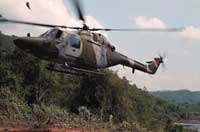 |
Fast and agile, the Lynx is a deadly tank-killer when equipped with eight TOW anti-armour missiles. Lynx is the British Army's primary battlefield utility helicopter. Two versions are in service with the Army - the AH7 with skids, and the wheeled AH9. Lynx helicopters can also carry missile counter-measures, a stabilized roof sight and door guns.
Crew 2(3 with door gunner) + 10 troops Length (Fuselage) 12.06m; Height 3.4m; Engines 2 x 850 shp Rolls-Royce Gem 41 Max Speed 330 kph; Cruising Speed 232 kph; Range 885km; Combat radius approx 100kms with 2 hour loiter Weight (max take off) 4.763 kg; Armament (if fitted) 8 x TOW Anti-armour Missiles, 2-4 7.62mm GPMG machine guns |
| Apache AH Mk1 (WAH 64 Apache Longbow) |
|---|
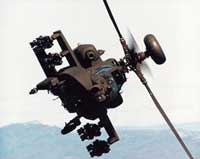 |
Designed to hunt and destroy tanks and other difficult and important targets, the Westland Apache Longbow provides a major enhancement to the Army's operational capability. The aircraft can operate in all weathers, day or night, and can detect, classify and prioritise up to 256 potential targets at a time. Apart from the distinctive 'Longbow' mast-mounted radar, the aircraft is equipped with a 127x magnification TV system,36x magnification thermal imaging, and 18x magnification direct view optics. Apache Longbow can carry 16 Hell-fire 'fire-and-forget' anti-armour missiles, 76 2.75in rockets and a 30mm chain gun.
Crew: 2 Gross Weight: 7,746 Kgs Engines: 2 x 850 shp Rolls Royce RTM-322 Maximum speed: 330 kph Cruise Speed: 272 kph Service ceiling: 3,505 m Combat radius Approx: 462 km Armament: 16 x Hellfire missiles, 76 x 2.75" rockets, 1200 x 30mm cannon rounds Surveillance/Target Acquisition: TV (127 x mag), Thermal Imaging (36 x mag), Direct view optics (18 x mag) |
| Gazelle Helicopter |
|---|
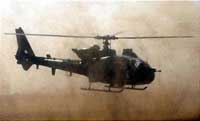 |
The primary role of Gazelle is observation and reconnaissance. It is a
vital component of anti-tank helicopter operations and is also used in a wide
variety of supporting roles - Air Observation Post(AOP) - to direct Artillery
fire, Airborne Forward Air Controller(ABFAC) - to direct ground-attack
aircraft, casualty evacuation, liaison, and command and control, and
communications relay. Equipped with a Ferranti AF 532 stabilised, magnifying
observation aid.
Crew: 2+3 passengers Length (Fuselage): 9.53m; Height: 3.18m; Rotor Diameter: 10.5m; Maximum Speed: 265 kph; Cruising Speed: 233 kph; Range: 670km; Engine: 592 shp Turbomeca/Rolls-Royce Astazou 111N2; Weight: 1,800 kg (max take off); Combat Radius Approx: 100 Km with 2 hour loiter. Armament: 2 x 7.62mm machine guns (not a standard fitting). |
| Islander | |
|---|---|
 | The Britten - Norman Islander was introduced into service with the Army Air Corps as a replacement for the ageing Beaver. Fulfilling a variety of roles such as surveillance, air photography and airborne command post, the Islander is currently deployed with 1 Flight AAC in Northern Ireland. |
Landing Craft and Assault Boats
| Assault Boat | |
|---|---|
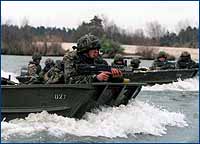 |
The Mk 5 Assault Boat is usually paddled for a silent or night-time approach. The all aluminum boat can be carried by four men or dragged overland by two. A versatile, general purpose craft designed to carry up to 20 troops or 1,043kg of stores, it also makes a useful ferry craft when fitted with an outboard motor. It is fitted with built-in grab rails, buoyancy tanks and protective keels (which act as stabilisers in the water). Assault Boats may be stacked six deep for storage or transport. |
| Rigid Raider | |
|---|---|
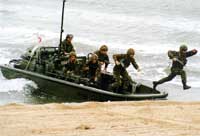 | In service with the Royal Engineers, Rigid Raiders are fast patrol craft with glass reinforced plastic (GRP) hulls, used for patrolling coastal and inland waterways. The craft are equipped with single or twin 140hp outboard motors and come in two versions: Mk 1 (coxswain plus 8 troops, or 1,000kg of stores, maximum speed 50kts light, 30kts laden) and Mk 2 (coxswain plus 10 troops and 650kg of stores, or 20 troops, maximum speed 30kts laden). |
| Mexeflote | |
|---|---|
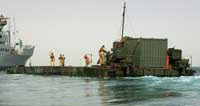 | The Mexeflote is a modular system comprising bow, centre and stern pontoons, which can be combined to form a powered raft, jetty, causeway or breakwater. Designed for maritime use, Mexeflotes are operated as ship-to-shore ferries by the Royal Logistics Corps (RLC) at Marchwood Military Port, in the Falkland Islands and elsewhere. |
Complement 6 (2 NCOs). Length Bow 7.92m, centre 6.1m, stern 6.1m. Beam 2.44m. Depth 1.45m. Weight Bow 59.09kg, centre 46.54kg, stern 44.18kg. Engines 2 x75hp Hydromaster 6-cylinder diesel. Payload 20.12 x 7.32m 60,000kg: 38.41 x 7.32m 120 tonnes; 38.41 x 12.2m 180 tonnes | |
| Landing Craft Vehicle/Personnel (LCVP) | |
|---|---|
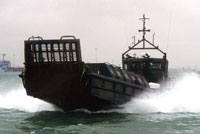 | Four Landing Craft Vehicle/Personnel (LCV/P) are used by the Royal Logistics Corps (RLC) in the Falkland Islands and the UK. Each can carry 20 fully-equipped troops, a vehicle and trailer, or 5.5 tonnes of equipment. |
Complement 3. Length 13.4m. Beam 3.3m. Draught (laden) 0.8m. Displacement (laden) 16 tonnes. Engine 2 x Perkins T6.3544 diesel. Maximum speed (laden) 15kts. Range 150 miles. | |
| Combat Support Boat | |
|---|---|
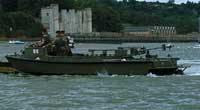 | The Combat Support Boat (CSB) is a powerful, versatile craft whose major role is to support both bridging and amphibious operations. Water jet propulsion allows high thrust at shallow draught. It can also be used as a general-purpose working boat in support of diving operations, ship-to-shore re-supply and inland water patrols. The boat is carried on a purpose-built launching and recovery trailer. It is used exclusively by the Royal Engineers. |
| Ramped Craft Logistic (RCL) | |
|---|---|
 | The Ramped Landing Craft Logistic (RCL) is used for amphibious operations and is designed to deliver men and material onto beaches. The craft are crewed by the Royal Logistics Corps (RLC). Two RCLs - Andalsnes and Akyab - are based in Cyprus. |
Complement 6 (2 NCOs) Length 33.3m Beam 8.3m Maximum draught (laden) 1.5m Displacement (laden) 290 tonnes Engine 2 x Dorman 8JTCWM diesel Maximum speed (laden) 10kts | |
Nuclear, Biological and Chemical Defence Systems
| Fuchs | |
|---|---|
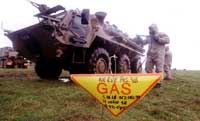 | Fuchs is an amphibious, 6 wheeled vehicle with a water speed of 10 kph, also called Panzer 1 in Germany where it is manufactured. First purchased in NBC Reconnaissance version by the British Army during the Gulf War, this vehicle will become the core element of the UK's Nuclear, Biological and Chemical Defence Regiment. Currently under development at the Chemical Defence Establishment, the vehicle will be equipped with the joint US/UK Integrated Biological Detection System (IBDS) for NBC Defence work. |
Configuration 6 x 6 Road Range 800 kms Crew 2 Operational Loaded Weight 18 tonnes Length 7.3m Width 2.98m Height 2.43m; Max Road Speed 105 kph Engine Mercedes Benz V8 liquid cooled diesel; Armament 1 x 7.62mm machine gun, 6 x Smoke Dischargers | |
| Nerve Agent Immobilised Enzyme Alarm and Detector-Level 3 | |
|---|---|
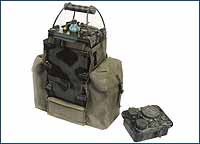 | NAIAD is an automatic alarm system which continually monitors the surrounding atmosphere to provide audible or visual warnings of the presence of nerve agent in either vapour or aerosol forms. The equipment consists of a detector and 3 remote alarms which operate up to 500m away from the detector. NAIAD is a wet chemistry technology based on the enzyme cholinesterase. |